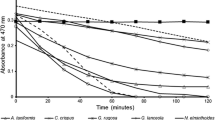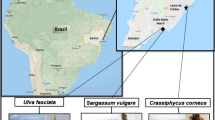Abstract
Fresh seaweeds, both wild and cultivated,are commonly eaten as food in the HawaiianIslands. Before Western contact, limu (seaweed) was a regular part of thediet, and is thought to have contributedvitamins and essential mineral nutrientsnot found in other staple food items. Twenty-two species of edible Hawaiianmacroalgae (6 Chlorophyta, 4 Phaeophyta, 12Rhodophyta) were analyzed for protein,lipid, carbohydrate, ash, caloric, mineraland vitamin content. Halymeniaformosa and Porphyra vietnamensisranked highest in total protein contentamong the species analyzed. Most speciescontained less than 5% crude lipid,although two Dictyota species hadover 16% crude lipid based on dry weight. Soluble carbohydrates ranged from 4.5 to39.9% dry weight. Ash values ranged from22.4% to 64.2%. Dictyotasandvicensis and Monostromaoxyspermum had caloric content each over3000 cal g-1 ash-free dry weight. Allspecies contained measurable quantities of11 essential mineral elements. The majorityof Hawaiian seaweeds tested containedβ-carotene (vitamin A), and Enteromorpha flexuosa contained thehighest amount of vitamin C (3 mg g-1).
Similar content being viewed by others
References
Abbott IA (1978) The uses of seaweed as food in Hawaii.Econ.Bot. 32: 409–412.
Abbott IA (1996) Limu.An Ethnobotanical Study of Some Hawaiian Seaweeds.National Tropical Botanical Garden, Kauai: 39 pp.
Abbott IA (1999) Marine Red Algae of the Hawaiian Islands.Bishop Museum Press, Honolulu: 477 pp.
Arasaki S, Arasaki T (1983) Vegetables from the Sea.Japan Pub.Inc, Tokyo: 196 pp.
Association of Official Analytical Chemists (1995) OfficialMethods for Analysis, 16th edn.AOAC, Washington, D.C.
Burkholder PR, Burkholder LM, Almodovar LR (1971) Nutritive constituents of some Caribbean marine algae.Bot.mar. 14: 132–135.
Carefoot TH (1985) Calorimetry.In Littler MM, Littler DS. (eds), Handbook of Phycological Methods.Ecological Field Methods: Macroalgae.Cambridge Univ.Press, New York, pp.479–491.
Chan JCC, Cheung PC, Ang Jr. PO (1997) Comparative studies on the effect of three drying methods on the nutritional composition of seaweed Sargassum hemiphyllum (Turn.) C.Ag.J.Agric.Food Chem. 45: 3056–3059.
Chapman VJ, Chapman DJ (1980) Seaweeds and Their Uses, 3rd edn.Chapman and Hall, New York: 334 pp.
Cho DM, Kim DS, Lee DS, Kim HR, Pyeun JH (1995) Trace components and functional saccharides in seaweed-1 Changes in proximate composition and trace elements according to the harvest season and place.Bull.Korean Fish.Soc. 28(1): 49–59.
Coppejans E, Prud'homme van Reine WF (1992) Seaweeds of the Snellius-II Expedition.Botanical results.List of stations and collected plants.Bulletin des Séances de l'Académie Royale des Sciences d'Outre-Mer 37: 667–712.
Darcy-Vrillon B (1993) Nutritional aspects of the developing use of marine macroalgae for the human food industry.Int.J.Food Sci.Nutr. 44: S23–S35.
De Clerk O (1999) A revision of the genus Dictyota Lamouroux (Phaeophyta) in the Indian Ocean.Ph.D.Dissertation, Gent University, Belgium: 406 pp.
Department of Land and Natural Resources (1990) Report to the governor, 1989–1990.State of Hawaii, Honolulu: 120 pp.
Department of Land and Natural Resources (2002) Report to the governor, FYS 1999, 2000, 2001.State of Hawaii, Honolulu: 178 pp.
Dubois M, Gilles FA, Hamilton JK, Rebers PA, Smith F (1956) Colorimetric method for the determination of sugars and related substances.Analyt.Chem. 28: 350–356.
Fan X, Han L, Zheng N (1993) The analysis of nutrient components in some Chinese edible seaweeds.Chinese J.mar.Drugs 12(4): 32–38.
Folch J, Lees M, Sloan-Stanley GH (1957) A simple method for the isolation and purification of total lipids from animal tissues.J.biol.Chem. 226: 497–507.
Fortner HJ (1978) The limu eater, a cookbook of Hawaiian seaweed.Sea Grant Miscellaneous Report UNIHI-SEAGRANT-MR-79-01, UH Sea Grant College Program, Honolulu: 102 pp.
Harrison PJ, Thomas TE (1988) Biomass measurements: protein determination.In Lobban CS, Chapman DJ, Kremer BP (eds), Experimental Phycology: a Laboratory Manual.Cambridge Scientific Press, New York: pp.27–34.
Harry JV (1934) An investigation of the iodine content of Hawaiian marine foods.Master of Science thesis, Chemistry, no.44, University of Hawaii, Honolulu: 40 pp.
Haytowitz DB, Matthews RH (1984) Composition of foods: vegetables and vegetable products.U.S.Dept.Agr, Agr. Handbook no.8–11, 502 pp.
Kennish R, Williams GA (1997) Feeding preferences of the herbivorous crab Grapsus albolineatus: the differential influence of algal nutrient content and morphology.Mar.Ecol.Progr.Ser. 147: 87–95.
Lahaye M (1991) Marine algae as sources of fibres: determination of soluble and insoluble dietary fibre contents in some "sea vegetables'.J.Sci.Food Agric. 54: 587–594.
Lowry OH, Rosebrough NJ, Farr AL, Randall RJ (1951) Protein measurement with the Folin phenol reagent.J.biol.Chem. 193: 265–275.
Magruder WH (1988) Sargassum (Phaeophyta, Fucales, Sargassaceae) in the Hawaiian Islands.In Abbott IA (ed.), Taxonomy of Economic Seaweeds with reference to some Pacific and Caribbean species.Calif.Sea Grant College Program 2: pp.65–87.
McDermid KJ, Stuercke B (in press) A comparison of the nutritional composition of Hawaiian Gracilaria species.In Abbott IA, Mc-Dermid KJ (eds), Taxonomy of Economic Seaweeds.Hawaii Sea Grant College Program 9.
Miller G (1927) Food value of poi, taro and limu.Bernice P.Bishop Museum T.H.Bull.37: 1–25.
Montgomery WL, Gerking SD (1980) Marine macroalgae as food for fishes: an evaluation of potential food quality.Env.Biol.Fish. 5: 143–153.
Naidu KA, Tewari A, Joshi HV, Viswanath S, Ramesh HP, Rao SV (1993) Evaluation of nutritional quality and food safety of seaweeds of India.J.Food Safety 13: 77–90.
Norziah MH, Ching CY (2000) Nutritional composition of edible seaweed Gracilaria changgi.Food Chem. 68: 69–76.
Portugal TR, Ladines EO, Ardena SS, Resurreccion L, Medina CR, Matibag PM (1983) Nutritive value of some Philippine seaweeds part II.Proximate, amino acid and vitamin composition.Philipp.J.Nutr. Oct-Dec: 166–172.
Qasim R (1986) Studies on fatty acid composition of eighteen species of seaweeds from the Karachi coast.J.chem.Soc.Pak. 8: 223–230.
Reed M (1907) The Economic Seaweeds of Hawaii and Their Food Value.Annual report of the Hawaii Agricultural Experimental Station 1906: pp.61–88.
Robledo D, Freile Pelegrin Y (1997) Chemical and mineral composition of six potentially edible seaweed species of Yucatan.Bot.mar. 40: 301–306.
Schwartz M (1911) Nutrition investigation on the carbohydrates of lichens, algae and related substances.Conn.Acad.Arts and Sci, Trans. 16: 247–382.
Zemke-White WL, Clements KD (1999) Chlorophyte and rhodophyte starches as factors in diet choice by marine herbivorous fish.J.exp.mar.Biol.Ecol. 240: 137–149.
Author information
Authors and Affiliations
Rights and permissions
About this article
Cite this article
McDermid, K.J., Stuercke, B. Nutritional composition of edible Hawaiian seaweeds. Journal of Applied Phycology 15, 513–524 (2003). https://doi.org/10.1023/B:JAPH.0000004345.31686.7f
Issue Date:
DOI: https://doi.org/10.1023/B:JAPH.0000004345.31686.7f




